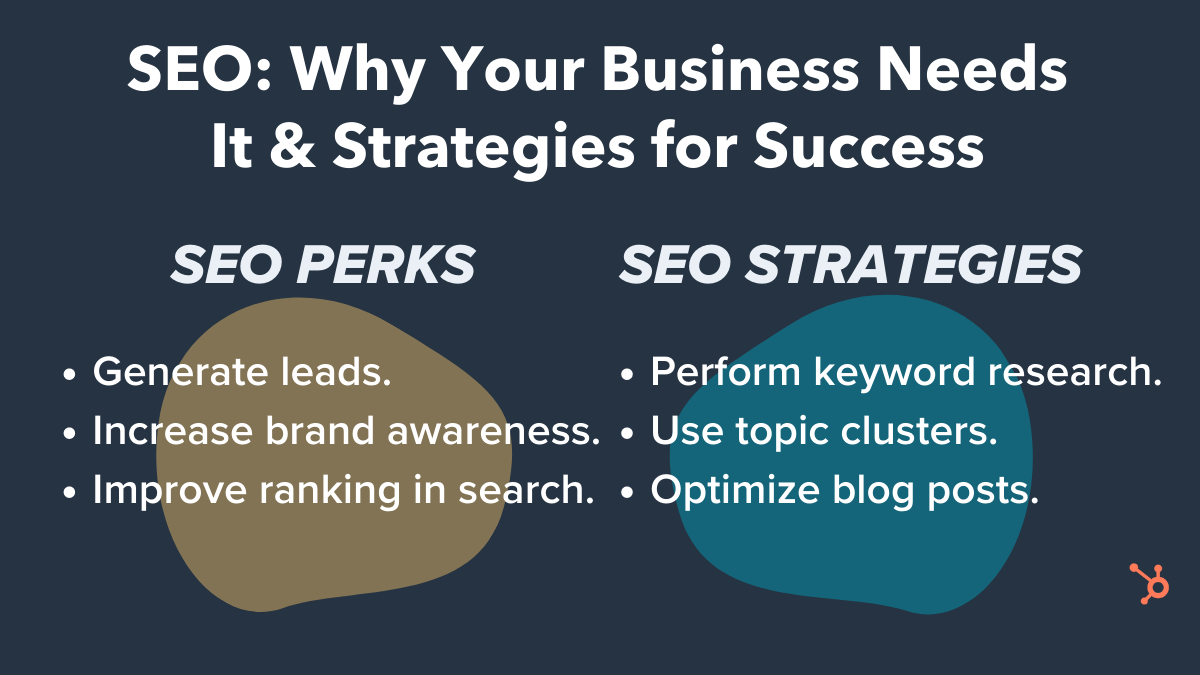Nowadays, you can’t conduct a successful content marketing strategy without incorporating SEO methods.
Neil Patel explained it well when he wrote: “Good SEO … means consistent output of content. Consistent output means that you’re doing content marketing, and you’re doing it right. There isn’t any way around it.”
I can imagine you might be thinking — “OK, but my goal for content marketing isn’t just SEO. It’s also creating thought leadership content, and lead generation, as well.”
Of course, every marketer should consider more than organic traffic when analyzing success metrics. After all, SEO isn’t the only component of a successful marketing strategy.
But SEO efforts don’t just help you reach organic traffic goals — they can also help you achieve your brand awareness and lead generation goals, as well.
Here, let’s explore how SEO can help you meet all your marketing goals, even if those goals don’t require organic traffic.

How SEO Can Help You Reach the 3 Main Content Marketing Goals
Before we dive into how marketers can use SEO strategies to reach their content marketing goals, let’s take a short detour and refresh ourselves on three of the primary reasons for doing content marketing:
- Lead generation. If you have salespeople ready to close sales but need to fill their pipeline with more qualified leads, the primary goal for your content marketing is probably lead generation. Lead generation is the process of converting people who’ve heard of your company into people who want to hear from your company more often. And then when those leads trust you and view you as an expert in your industry, they’re more likely to convert into customers.
- Thought leadership/brand awareness. If you’re hoping to position your company as a knowledgeable expert within your industry, your primary content marketing goal is probably thought leadership. Consistently getting thought leadership content published in trusted publications — whether through guest-contributed articles or press mentions — is a fantastic way to build credibility with your audience.
- SEO. If there’s a lot of competition in your space and you’re gunning for the top spot in your target audience’s mind, your primary goal for content marketing is probably SEO. SEO works to get your website to the top of the list when your audience looks for certain keywords in search engines. The content on your site and the pages that link to your site give your website a better score, boosting your overall credibility with the search engine.
If you didn’t have a specific content marketing goal in mind before you started reading, pick the one from the list above that’s most important to you right now. Keep that goal in mind as you keep reading.
SEO Strategies to Reach Any Content Marketing Goal
Now that you have a specific goal in mind, let’s take a look at a few SEO strategies that can help you improve your content marketing results, as well as how you can apply these SEO strategies to reach your content marketing goals.
1. Keyword Research
To put it simply, keyword research lets you see what search terms you’re currently ranking for, what others in your industry are ranking for, and which keywords could use more of your attention.
For example, you might discover that your audience is looking for “guides on creating a content marketing strategy.” While a certain publication you want to partner with might not be looking for an article that spells this out in a lengthy, detailed how-to guide, you could write a higher-level article for that publication that links to a white-paper on your site that dives deeper into the process of developing an effective content marketing strategy.
This would allow you to create content that your audience is looking for, while also publishing in an important publication that helps demonstrate your brand as a thought leader in the industry. Of course, researching your keywords will look the same regardless of your content marketing goal — but the way you use that information will differ.
If your primary goal is lead generation, keyword research can enable you to identify pain points or sales objections you might want to cover in your content. This will allow you to tailor your content to what your audience actually wants to know and strategically use keywords related to your audiences’ searches so you can reach them in search results. Once you reach them there, you can hopefully lead them to your site to engage with your company further.
Focusing on thought leadership? Keyword research can help you find out what questions your audience has so you can provide answers and position your company as authorities in your industry. You can include short-tail (e.g., “AI”) and long-tail (e.g., “what is artificial intelligence”) keywords in your content to rank for those keywords and further solidify your place as a thought leader online. After all, if your audience members don’t find you when they search for information related to your expertise, they probably won’t consider you a credible expert.
If SEO is your focus, keyword research lets you see how you stack up against the competition when it comes to ranking for important keywords in your industry. It will give you insight into what keywords your content initiatives should focus on so you can improve those rankings and be more competitive on search engine results pages.
To conduct keyword research, analyze your website’s current rankings, identify keywords your competition doesn’t rank for but that might be good opportunities, look for question-based keywords you can focus on to answer your audience’s queries, and cluster your findings so you can identify trends. Google’s autocomplete, similar searches, or Keyword Planner are accessible ways to explore what your audience is searching for. If you want to go deeper, you can use a keyword tool like Ahrefs, SEMrush, or Moz to get a more well-rounded picture.
2. Topic Clusters
Search engines’ algorithms favor topic-based content, so it can be beneficial to link related content under “topic clusters.” Basically, building topic clusters allows you to provide deeper coverage across a range of core topics and create an efficient information architecture.
You can develop a pillar page for each of your company’s main focus areas. Then you’ll build out more specific subtopics, or “cluster content.” These pieces of cluster content will provide more detail related to a specific long-form keyword that’s related to the main topic you covered on the pillar page. The pillar links to each cluster page, and each piece of cluster content links back to the pillar with the same hyperlinked keyword.
For example, at my company, Influence & Co., we created a pillar page titled “The Ultimate Guide to Content Marketing.” This is a longer piece of content that covers six ways readers can take their content marketing to the next level, diving deep into how to achieve the advice in each section. This pillar page links out to multiple cluster pages (and the cluster pages link back), which results in that solid architecture I just mentioned.
We also produced a couple of guest-contributed articles related to this pillar page to create a comprehensive content plan that provides a wide range of specific, tactical content to help our audience better understand content marketing — and how to do it well.

If you’re focusing on lead generation, this linking ecosystem enables you to keep your audience members engaged with your content longer, which boosts the likelihood that they’ll fill out a form or reach out to you. Plus, as your audience members spend more time on your site, they learn more about your company, making them more qualified leads once they do decide to take the leap and give you their information.
Topic clusters can benefit a thought leadership strategy as well, because this approach lets you create overview content and in-depth content, which positions you as a thorough expert on the subject matter that your audience is interested in and cares about.
Finally, working to achieve SEO goals? This model can help you organize your site’s structure.
Building a strong information architecture can lead to better rankings in organic search across a broad subject area. Those hyper-focused pieces of cluster content will allow you to work toward that strong architecture while also maintaining your focus on producing content that your audience cares about. Plus, creating one high-performing cluster page can elevate search rankings to all of the other pages that are linked to the same pillar.
A great way to plan out your topic clusters is to develop a content map. Before you even begin creating content, decide what your pillar page will focus on. Then nail down topics for a few cluster pages. You can even take it a step further and identify what subjects you’d like to cover in guest-contributed articles related to that overarching topic. We’ve put together a free content map template that you can use to get started.
3. Optimizing Blog Posts
Blogging can position your website as a relevant answer to your target audience’s burning questions. And optimizing those posts for search can help you actually reach your audience members so you can provide the value they’re looking for.
Blog post optimization can advance both thought leadership and lead generation goals because if the content you’re producing for your site isn’t ranking well, it isn’t showing up as a relevant answer to your audience’s questions. This means you won’t be perceived as an expert, and you most definitely won’t generate more leads.
If you’re focusing on SEO as your primary goal, optimizing blog posts is a given. Your content isn’t going to rank well if you’re not including relevant short- and long-tail keywords that your audience cares about.
To optimize your blog content, focus on one or two long-tail keywords that line up with the intent of your target readership, and include those keywords in your post where they fit in naturally. For example, if your audience has been searching for information on creating a predictive analytics strategy, you’ll want to publish a blog post about the strategy and techniques behind predictive analytics.
When writing that post, you’ll need to include long-tail keywords for which people are searching. Those might include “how to do predictive analytics,” “predictive analytics strategies,” and “predictive analytics techniques.” This way, your blog post will show up in search results for people who are looking for more detailed insights on developing a predictive analytics strategy.
In addition, make sure your blog is responsive and mobile-friendly. Creating a meta description that’s keyword-rich, optimizing your images with alt text, and linking to other pages on your blog whenever possible will also help you rank.
These are just a few SEO strategies that can help you reach your content marketing goals, whether you’re focusing on SEO itself, thought leadership, or lead generation. This certainly isn’t an exhaustive list, but it’ll get you started on your journey of optimizing your way to better content marketing results.
![]()
Original Entry: Why You Should SEO-Optimize Your Content, Even if Your Goal Isn’t Organic Traffic is shared from https://blog.hubspot.com/marketing/how-seo-can-help-nonorganic-goals via https://blog.hubspot.com/marketing
Check out the original post, Why You Should SEO-Optimize Your Content, Even if Your Goal Isn’t Organic Traffic that is shared from https://putyourfamilyfirst.wordpress.com/2020/07/28/why-you-should-seo-optimize-your-content-even-if-your-goal-isnt-organic-traffic-2/ via https://putyourfamilyfirst.wordpress.com
No comments:
Post a Comment